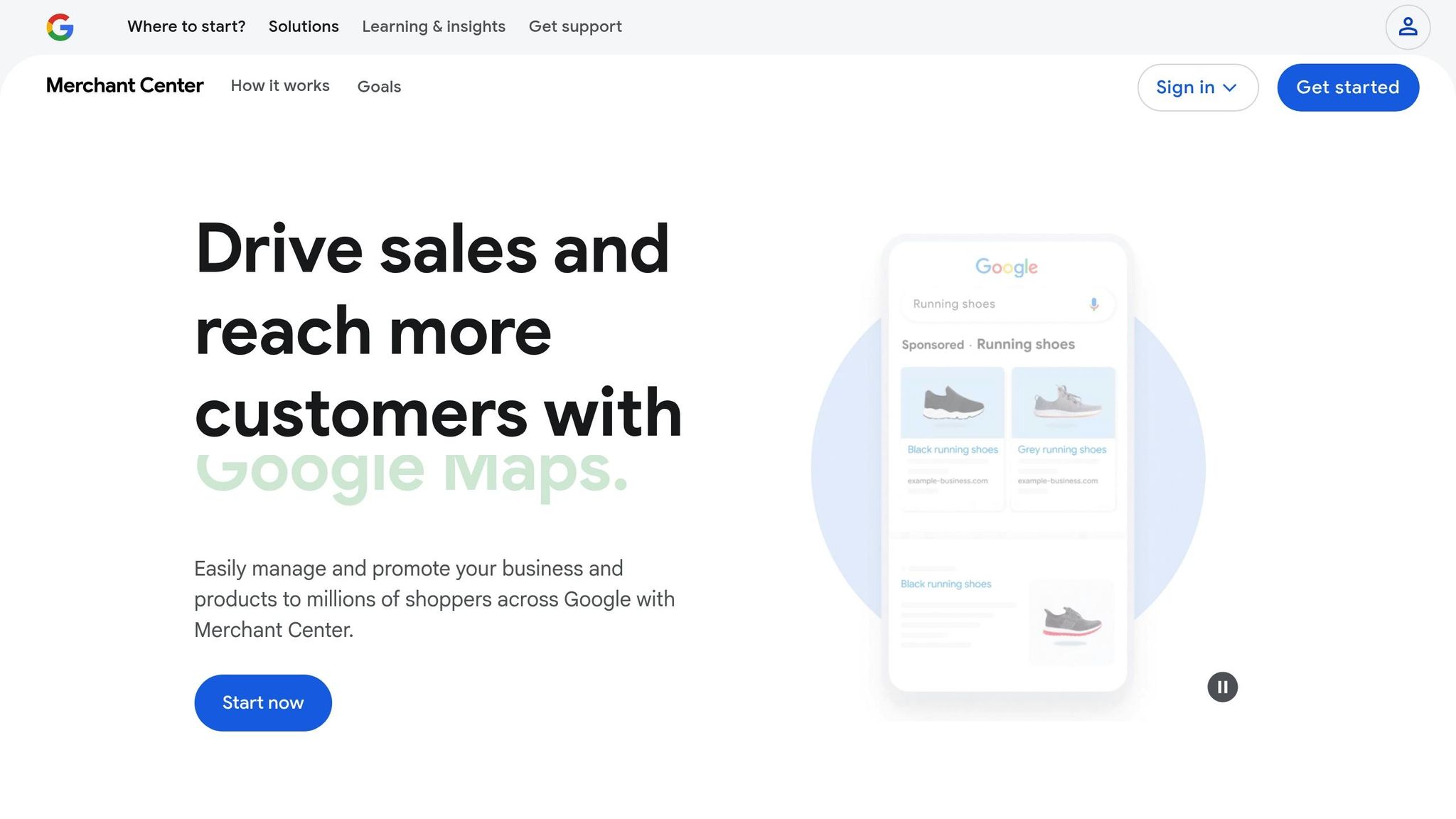5 Common Product Feed Errors and How to Fix Them
Product feed errors can cost you visibility, sales, and even your ad account. These mistakes disrupt e-commerce campaigns, leading to disapproved ads, higher costs, and frustrated customers. Here’s a quick rundown of the 5 most common errors and how to fix them:
Missing Attributes: Forgetting key details like shipping info or GTINs causes 23.49% of ad disapprovals. Regular feed audits and validation tools help solve this.
Price & Currency Issues: Incorrect formats (e.g., missing "$" or wrong decimals) lead to feed rejections. Standardize pricing and automate validation.
Stock Inaccuracy: Outdated inventory data wastes ad spend and annoys customers. Sync stock updates in real time.
Product ID Errors: Duplicate or invalid GTINs reduce visibility. Audit and validate product IDs regularly.
Category Mistakes: Misclassified products lower visibility and cause disapprovals. Map categories to platform taxonomies and monitor updates.
Quick Fixes:
Automate feed updates daily for pricing and inventory.
Validate data for errors before submission.
Align categories and attributes with platform requirements.
These simple steps can keep your product feed error-free, boosting ad performance and sales.
Fix Invalid and Missing GTIN Errors in Google Merchant Center

1. Required Attributes Missing From Feed
Leaving out essential feed attributes is like listing a house for sale without mentioning its location or size - key details that buyers need. This issue affects roughly 5-10% of all product listings, with Magento merchants facing the highest rate, where nearly 10% of their advertised products are impacted [2].
Effects on Ad Campaign Results
Missing attributes can significantly hurt your advertising efforts:
Immediate Disapprovals: Missing shipping information alone accounts for 23.49% of all product ad disapprovals [2]. Platforms like Google Shopping may reject products with incomplete data, meaning they won’t show up in search results.
Higher Advertising Costs: Incomplete product data often leads to lower quality scores. This means higher cost-per-click rates, reduced ad visibility, and ultimately, a lower return on ad spend.
Here are the most problematic missing attributes and their impact:
| Attribute Type | Impact | Rejection Rate |
|---|---|---|
| Shipping Info | Prevents Listing | 23.49% |
| Image Attributes | Reduces Visibility | 20.32% |
| GTIN Numbers | Affects Matching | 5.50% |
Steps to Add Missing Data
To fix missing attributes and improve your feed quality, follow these steps:
Feed Audit
Regularly review your feed for essential fields, such as:Clear and concise product titles (note: 25.82% of listings exceed optimal character limits)
Accurate pricing information
Complete, detailed product descriptions
Valid GTINs for branded items
High-quality images with correct attributes
Data Validation
Use a validation system to ensure:Products can’t be published without all required attributes
Formatting errors are caught automatically
Missing or incorrect data is flagged before submission
Frequent Updates
Schedule updates to keep your feed accurate:Daily for price and inventory changes
Weekly for a full feed review
Monthly for in-depth data quality checks
Channel-Specific Templates
Different platforms have unique requirements. For example:Google Merchant Center requires strict GTIN compliance
Facebook allows MPNs as a substitute when GTINs aren’t available
Amazon demands detailed, category-specific attributes
With these steps in place, you’ll minimize errors and improve your product visibility. Next, we’ll dive into how pricing and currency format issues can further affect your feed performance.
2. Price and Currency Format Issues
Price formatting mistakes can seriously impact your product feed's performance. In fact, shipping and pricing issues together account for 23.49% of product ad disapprovals [2]. Just like missing attributes, correctly formatted prices are critical for smooth ad campaigns. Let’s break down the most common US-specific errors and how to fix them.
Common Price Format Errors
Here are some typical price formatting mistakes seen in US product feeds:
| Error Type | Example | Impact |
|---|---|---|
| Missing Currency Symbol | 19.99 instead of $19.99 | Feed rejection |
| Incorrect Decimal Format | $19,99 instead of $19.99 | Customer confusion |
| Mixed Format Usage | USD 19.99 | Platform disapproval |
| Thousand Separator Errors | $1,299.99 for amounts under $9,999 | Inconsistent display |
Each platform has its own rules, which can make things tricky. For instance, Google Merchant Center requires a dollar sign ($) before the price or the USD code after it. Amazon, on the other hand, omits currency symbols in feeds. Facebook/Meta expects the feed currency to match your store's, while Walmart Marketplace insists on two decimal places for all prices.
Fixing Price Format Errors
To avoid feed rejections and ensure consistent pricing, follow these steps:
Standardize US Price Formatting
Stick to these rules for US-based feeds:Always place the dollar sign ($) before the amount.
Use a period (.) as the decimal separator.
Include two decimal places (e.g., $19.00).
Skip thousand separators for prices under $10,000.
Automate Validation
Use automated tools to check:Proper placement of the currency symbol.
Accurate decimal formatting.
Consistency in pricing across all channels.
Matching prices between your feed and landing pages.
Update Prices Regularly
Schedule daily price updates, increase frequency during sales or volatile periods, and make immediate adjustments for special events.Ensure Platform Compliance
Each platform has unique pricing rules. For example, Google Shopping requires prices in your feed to exactly match those on your landing page. Even minor discrepancies can lead to disapprovals, which could hurt your campaign's performance.
3. Stock Level Accuracy Problems
Inaccurate inventory data can create chaos in e-commerce operations. For instance, 10% of Magento listings contain stock errors - a statistic that highlights how common and disruptive this issue can be [2].
Problems From Old Stock Data
Outdated inventory information leads to several complications that can hurt your business:
| Impact Area | Consequence | Recommended Solution |
|---|---|---|
| Customer Experience | Frustrated buyers unable to purchase unavailable items | Real-time stock updates |
| Ad Performance | Money wasted promoting products that are out of stock | Automated feed synchronization |
| Platform Status | Risk of account suspensions or ad disapprovals | Regular feed monitoring |
| Brand Trust | Negative reviews and loss of customer loyalty | Consistently accurate inventory data |
Take the example of a U.S. electronics retailer that ran into trouble during a holiday sale. Their system, which updated inventory just once a day, couldn’t keep up with the surge in demand. This resulted in sold-out items still being advertised, leading to angry customers and a temporary suspension on Google Shopping [2].
Stock Data Update Methods
Keeping your inventory data accurate is non-negotiable if you want your ads to perform well. Here are some effective strategies to maintain real-time accuracy:
Automated Synchronization: Set up your system to update inventory automatically whenever stock levels change. This eliminates delays and manual errors.
Multi-Channel Monitoring: Keep a close eye on key metrics like update frequency and out-of-stock rates. Quick detection of issues ensures you can fix them before they escalate.
Real-Time Integration: Use API connections to link your e-commerce platform with your feed management system. This ensures inventory updates are reflected instantly across all sales channels.
For businesses handling high sales volumes or operating across multiple platforms, scheduling validation checks during peak periods and setting up alerts for discrepancies can make a big difference. These proactive steps help prevent disruptions and keep your operations running smoothly.
sbb-itb-0bd1697
4. Product ID Errors
Product ID errors can seriously affect your ad performance. For instance, GTIN-related issues alone account for 5.5% of product feed errors [2].
Common ID Problems
These errors often fall into a few key categories, each with its own consequences:
| Error Type | Impact | Cause |
|---|---|---|
| Missing GTINs | Product disapprovals | Incomplete product data entry |
| Duplicate IDs | Listing overwrites | Poor inventory management |
| Invalid GTINs | Reduced ad visibility | Incorrect manufacturer information |
| Inconsistent IDs | Broken performance tracking | Conflicts from multi-channel selling |
Different e-commerce platforms show varying levels of feed errors:
Shopify: The most reliable, with just 5.47% of listings disapproved.
BigCommerce: Slightly higher error rate at 7.03%.
WooCommerce: Faces issues in 8.27% of listings.
Magento: Struggles the most, with nearly 10% of listings affected [2].
How to Correct Product IDs
You can tackle product ID problems by focusing on validation and consistency:
Audit Your Product Database
Review your catalog thoroughly to catch missing GTINs, duplicate entries, and any inconsistencies that could lead to disapprovals.Implement Validation Protocols
Cross-check GTINs with manufacturer databases.
Ensure IDs are unique and persistent.
Verify formatting across all platforms.
Document any custom identifier rules your business follows.
Maintain Data Consistency
Stick to unique IDs, preserve historical data, standardize formats, and perform regular audits to keep your product feed in shape.
Up next, we’ll dive into resolving product category errors in your feed.
5. Product Category Mistakes
Incorrect product categorization impacts up to 10% of listings on major e-commerce platforms, leading to reduced visibility, feed disapprovals, and even outright rejections [2].
Types of Category Errors
Category errors usually fall into three main types:
| Error Type | Impact | Example |
|---|---|---|
| Generic Categories | Lower visibility | Listing a product under "Beauty" instead of "Beauty > Skin Care > Face Care > Face Moisturizers" |
| Missing Requirements | Feed disapproval | Skipping attributes like age_group and gender for apparel items |
| Taxonomy Mismatch | Platform rejection | Using internal categories that don’t align with platform standards |
The frequency of these errors varies by platform. Magento sellers encounter the highest rate, with 10% of listings affected. WooCommerce follows at 8.27%, BigCommerce at 7.03%, and Shopify has the lowest rate at 5.47% [2]. To minimize these issues, it's essential to use accurate category mappings and regularly review your taxonomy.
Meeting Category Requirements
1. Map Categories Accurately:
Ensure your product categories align perfectly with the platform's taxonomy. For example, instead of listing running shoes under "Footwear", use a more specific path like "Sporting Goods > Athletic Clothing > Athletic Footwear > Running Shoes." This improves visibility and ensures compliance.
2. Monitor Taxonomy Updates:
Platforms frequently update their category structures. Set up a quarterly review process to stay on top of these changes and adjust your product feeds accordingly.
3. Use Category-Specific Attributes:
Including the right attributes enhances product discoverability and approval rates. Here's a quick guide for some common categories:
| Category | Required Attributes | Additional Attributes |
|---|---|---|
| Apparel | Size, Color, Gender | Material, Style |
| Electronics | Technical Specs | Energy Rating |
| Beauty | Size/Volume | Ingredients |
4. Implement Validation Checks:
Regularly validate your product data to ensure categories are assigned correctly, required attributes are included, and platform taxonomies are followed precisely.
5. Track Performance Metrics:
Keep an eye on feed approval rates and other performance metrics. Use this data to refine your categorization strategy and address any recurring issues.
Conclusion: Next Steps for Feed Improvement
Automated feed validation plays a key role in reducing errors and boosting product approvals [1]. Keeping your product feeds accurate and up-to-date demands constant attention and the right set of tools.
To build on the feed error fixes outlined earlier, consider this framework to keep your feeds running smoothly:
Medium Priority: Review your product attributes weekly to ensure all required details are complete, improving the overall quality of your listings.
Low Priority: Audit your category taxonomy monthly to ensure it aligns with platform standards.
High Priority: Run daily automated updates and checks on dynamic attributes like price and inventory.
Here’s an example: A leading US beauty retailer saw a noticeable improvement in product approval rates after implementing automated attribute validation and adhering to US-specific formatting rules [1]. These adjustments led to better ad visibility and, ultimately, stronger sales performance.
To maintain healthy product feeds:
Run daily automated updates to keep dynamic attributes like price and inventory accurate.
Use US-standard formatting, including currency with "$", dates in MM/DD/YYYY format, and appropriate measurement units.
Set up real-time error alerts to quickly address any issues that arise.
Conduct regular audits to uncover new opportunities for optimization.
FAQs
How can I keep my product feed compliant with platform requirements over time?
To keep your product feed in good standing, make sure to follow the specific data feed rules outlined by each platform, such as Google Shopping. These rules cover everything from required attributes to formatting and the type of information your listings need.
Keep your product details up to date - things like prices, stock levels, and descriptions. Regular updates not only prevent issues like disapprovals but also improve your feed's performance. Accuracy builds trust and ensures your listings comply with platform requirements.
Using product feed management tools can be a game-changer. These tools help identify and fix errors before they become bigger problems, saving you time while keeping your feed optimized for success on e-commerce platforms and in ad campaigns.
How can I automate updates to avoid common product feed issues like stock errors or price mismatches?
To avoid problems like stock discrepancies or incorrect pricing, automating your updates is a smart move. Regularly schedule product data uploads or take advantage of tools like the Content API for Shopping to simplify the process. If your pricing changes often, the Inventory API can make real-time updates much quicker and more reliable.
The best approach? Set your feed to update daily or whenever there are changes. Linking your online store directly to your feed using automated data exports or a feed management tool can boost both accuracy and efficiency. By automating these updates, you'll keep your product feed current, cut down on errors, and see better results overall.
How do I map product categories correctly to avoid feed errors and improve product visibility?
Accurately mapping your product categories to the platform's taxonomy is key to avoiding feed errors and improving product visibility. Take Google, for instance - it organizes products using its Google Product Category Taxonomy, a structured system that helps ensure items are easy to find and properly displayed to shoppers.
When completing the Google Product Category field, you have two options: use the full category name or the category ID. Getting this step right not only minimizes the chances of feed disapprovals but also makes your products more relevant in search results, boosting their visibility and performance in ad campaigns.
Geoffrey G.




